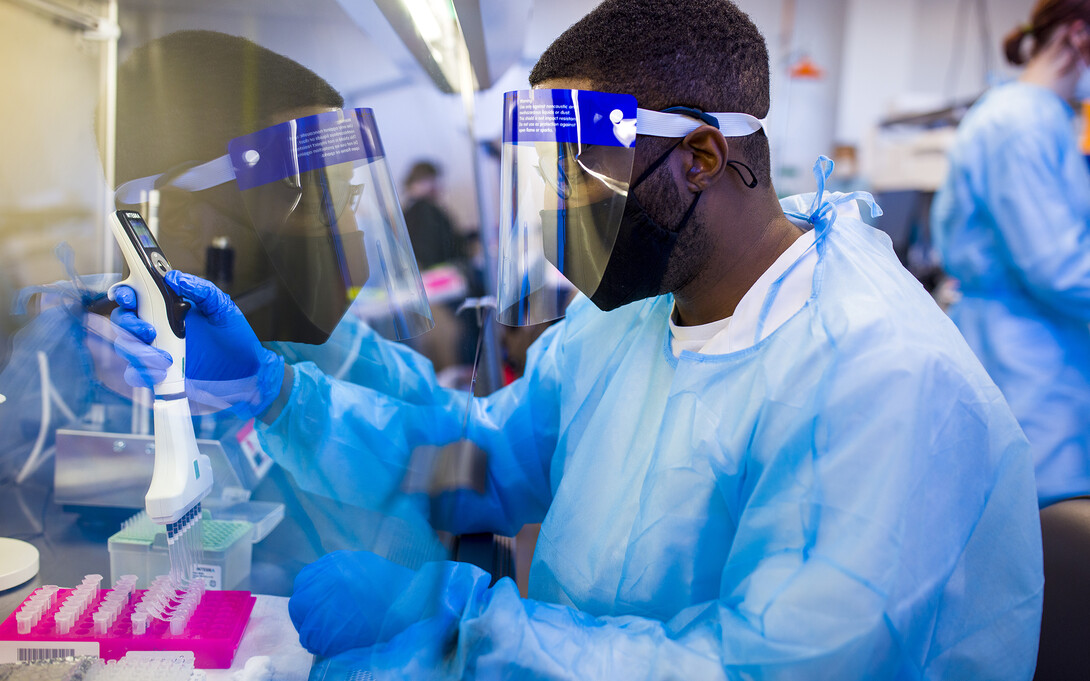
A year into the effort, the University of Nebraska–Lincoln’s saliva testing continues to keep the campus community safer and more protected against an ever-changing COVID-19 pandemic.
Much of the credit for the success, which has allowed in-person classes to continue, can be attributed to the COVID-19 task force and the hundreds of staff who continue to help make the effort possible — from mass producing the test kits and hiring and training workers to building the testing pods and answering thousands of emailed questions.
“When we partnered with Test Nebraska back in August 2020, we never would have imagined having a testing operation that would be capable of running thousands of tests each day with results being available within 24 hours,” Becky Zavala, assistant vice chancellor for research and economic development, said. “As the campus’s needs changed, so did the testing program.”
The university first partnered with Test Nebraska and the Nebraska Public Health Lab to gear up for in-person classes, following nearly two terms completed remotely. The testing was done in the parking garage at 17th and R streets, and mostly was used by students, faculty and staff who were showing symptoms. The partnership was successful, but the COVID-19 task force, comprised of campus leaders from several units, realized that a larger testing push was needed to know the full scope of the pandemic on campus.

Jennifer Nelson, assistant vice chancellor for research, had helped oversee the Test Nebraska partnership and was again asked, along with Zavala, to run logistics for an on-campus testing program. The task force turned to the Nebraska Veterinary Diagnostic Center, which was able to do polymerase chain reaction testing — the gold standard for detecting the SARS-COV-2 virus.
“As the (fall) semester went along, we had a winter surge of COVID-19 looming, and we started to recognize that we were going to need to offer a significantly higher volume of tests that would be less invasive, and where we could have really quick turnaround of results,” Nelson said. “(Saliva testing) had been done on other campuses, but we also didn’t have a medical center on campus. Our vet diagnostic center is very skilled at doing diagnostic testing, and had much of the underlying architecture and compliance and regulatory aspects to do this type of work.”
To use the Veterinary Diagnostic Center for PCR testing, the lab would need additional staffing and space to scale up the ability to run hundreds or thousands of samples a day. Starting in November 2020, Duan Loy, molecular diagnostics lab manager, and Bruce Brodersen, director of the center, oversaw the expansion. They turned an empty room into a full-fledged COVID-19 testing lab, complete with biosafety measures.
“We worked really hard to prepare everything for launch in January,” Loy said. “We hired 40 new staff, and I was interviewing up to eight a day and then we had a week to train them. The purchasing and IT teams helped us make things happen really fast, and the university was really helpful in making sure we had everything we needed.
“Having run nearly 300,000 tests already, compared to the usual work of the Veterinary Diagnostic Center, that’s about 20 years of work, because normally we run about 7,000 PCR a year.”

Additional test collection sites had to be identified, and staff from University Housing and Facilities, Maintenance and Operations stepped up to build and power pods for some of the outdoor collection sites.
“The housing and facilities teams were happy to hear whatever we thought we needed and happy to build it in record time,” Nelson said. “We tried to situate the testing sites in a manner that would be convenient no matter where you lived or worked on campus.”
Throughout each day, couriers are delivering collection samples to the lab, which runs day and night to process all of the tests, Loy said, ensuring the 24-hour turnaround. That was important for campus, Zavala said, especially as test turnaround times for the public lagged to four or five days when case numbers peaked. The in-house testing program allowed campus community members to know their status more quickly, isolate students in separate housing when they tested positive, and helped local public health officials gauge the presence of COVID-19 in the community.
“I think a huge part of our success in continuing to offer an in-person experience for our students has been our ability to be flexible and to adapt to the ever-changing circumstances,” Zavala said. “I cannot imagine that we could have accomplished that level of flexibility without the decision to develop an in-house testing operation.”
None of it could have been possible without the work of hundreds on campus, Nelson said.
“So many selfless, team-oriented colleagues have given their all toward this and then some,” she said. “It’s been a true testament to the hard-working, can-do Nebraska spirit.”

A by-the-numbers look behind the scenes:
123: student workers hired to work at the test collection sites.
275,000: tests completed.
14: total testing sites that have been simultaneously running during peak times. These covered City and East campuses, Nebraska Innovation Campus and the University of Nebraska at Omaha.
40: new lab workers at the Veterinary Diagnostic Center to process the tests. The lab currently has 25 staff for SARS CoV2 testing.
20: new staff hired, including five nurses, dedicated to the COVID-19 response.
185: approximate number of volunteers who have helped with testing kits and collection during peak times, such as re-entry testing.
5,839: the record number of tests performed in one day, on Aug. 16, 2021.







